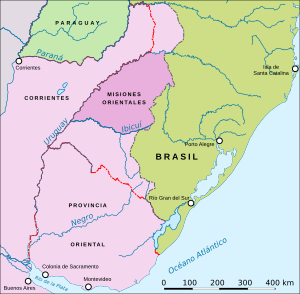Spanish–Portuguese War (1735–1737) facts for kids
Quick facts for kids Spanish–Portuguese War (1735–1737) |
|||||||
|---|---|---|---|---|---|---|---|
 The Banda Oriental |
|||||||
|
|||||||
| Belligerents | |||||||
| Commanders and leaders | |||||||
| António Pedro de Vasconcelos | Miguel de Salcedo y Sierraalta | ||||||
| Strength | |||||||
| About 2,000 Portuguese | About 2,000 Spanish 4,000 Guaranís |
||||||
The Spanish-Portuguese War was a fight between Spain and Portugal from 1735 to 1737. It happened in a place called the Banda Oriental, which is mostly Uruguay today. This war was about who owned this important land in South America.
Contents
Why Did the War Start?
Land Claims and Borders
In the 1700s, the Banda Oriental was a wild area with few people. It was right on the edge of where Portugal had its colony, Colonial Brazil, and where Spain had its own area, the Governorate of the Río de la Plata. Both countries wanted control of this land.
Spain believed the land was theirs because of an old agreement from 1494 called the Treaty of Tordesillas. But Portugal had built the very first city there, the Sacramento Colony, in 1680.
A City Changes Hands
Spain had taken the Sacramento Colony twice before. They captured it in 1681 and again in 1705. But each time, they had to give it back to Portugal. This happened because of peace treaties, like the Treaty of Utrecht in 1713.
Growing Portuguese Influence
After 1713, the Portuguese started to build more settlements around Sacramento Colony. Their influence spread out about 120 kilometers. Spain didn't like this at all.
To stop Portugal from expanding, the Spanish leader of Río de la Plata, Bruno Mauricio de Zabala, started a new city. He founded Montevideo on December 24, 1726.
Trade Troubles
The Portuguese in Sacramento Colony were also doing a lot of trade. This made things hard for the Spanish. Spanish traders had to send their goods through the Viceroyalty of Peru, which charged high taxes. The Portuguese trade was cheaper, but Spain saw it as illegal. They believed Portugal shouldn't be there, and their trade was against the rules.
The Conflict Begins
Orders from Spain
In March 1734, a new Spanish leader, Miguel de Salcedo y Sierraalta, got a clear order from Spain. He was told to make the Sacramento Colony much smaller. The order said its area should be only "a gunshot" wide, which meant about two kilometers.
Salcedo sent a message to the Portuguese governor, António Pedro de Vasconcelos. Vasconcelos didn't give a quick answer; he tried to gain time.
Rising Tensions
In 1735, the disagreements between Spain and Portugal grew worse. Spanish ships, led by a commander named Alzaybar, captured several Portuguese ships. On April 19, the Spanish Prime Minister, José Patiño, ordered Salcedo to attack Sacramento.
The Siege of Sacramento
Spanish Attack
Salcedo gathered about 1,500 soldiers. He marched slowly towards Sacramento, attacking smaller places along the way. About 4,000 Guaraní warriors also joined him. These warriors came from special communities called Jesuit Reductions.
The Spanish attack on Sacramento Colony began on October 14, 1735. This type of attack, where an army surrounds a city to try and take it, is called a siege.
Portuguese Defense
Governor Vasconcelos had prepared for the attack. He had about 900 men ready to defend the colony. He also sent a messenger to Rio de Janeiro to ask for help.
Help arrived quickly. On January 6, six Portuguese ships came, followed by 12 more ships a few days later. The Spanish had tried to stop ships from reaching Sacramento, but Portugal had more ships and took control of the sea.
In 1736 and 1737, both Spain and Portugal sent more ships. There were some small fights between ships, but neither side could win a clear victory at sea.
On September 6, 1736, the Portuguese even tried to attack Montevideo. But they had to leave when Salcedo sent 200 men to defend the city.
The End of the War
Peace Treaty
On March 16, 1737, a peace treaty was signed. Important countries like France, Great Britain, and the Dutch Republic helped make this happen.
In September, the Spanish stopped their siege of Sacramento. Their forces left the area. Miguel de Salcedo was removed from his job as governor of Buenos Aires.
This war was fairly small. Only a few thousand soldiers fought on each side.
Images for kids
See also
 In Spanish: Guerra hispano-portuguesa de 1735-1737 para niños
In Spanish: Guerra hispano-portuguesa de 1735-1737 para niños

